Physicist: If you’ve ever sat next to someone as they rang an almost-empty ice cream bowl like church bells on Sunday, then you’ve probably asked yourself some variation of this question.
Clearly, the issue is that a spoon and a bowl aren’t osculating curves. The radius of a spoon’s curvature is typically less than an inch while a bowl’s is several inches. With different curvatures, when you drag a spoon across the bottom of an ice-cream-laden bowl, they only contact each other at a tiny point and you can only remove ice cream along a thin strip (Matching the curvatures is why you instinctively start using the spoon sideways when the ice cream is low). So if you wanna get your bowl perfectly clean, you gotta figure out how wide that strip is.
Around the point of contact there’s a gap between the spoon and bowl that gets bigger the farther away you get. But so long as the ice cream molecules are bigger than that gap, they’ll be caught. Water, at about a quarter of a nanometer across, is the smallest molecule in ice cream’s molecular menagerie.
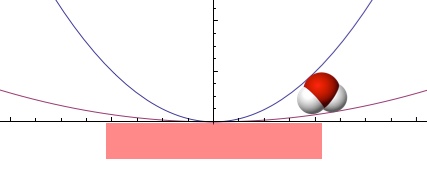
To figure out the width of the strip (red bar) removed by the pass of a spoon, you have to find how far you can get from the point of contact before the gap is big enough for the smallest molecules to pass through.
The bottom of a circle with a radius R can be closely approximated by a parabola of the form (There’s nothing too special about parabolas; every curve that doesn’t have sharp corners can be closely approximated by circles and vice versa, it’s just that parabola math is easy). Spoons have a radius of around 1 cm. Bowls have a radius of around 7 cm. The distance from the center (the point of contact) to the edge of the strip, x, such that water molecules won’t be able to slip through the gap between the bowl and the passing spoon is given by
. Solve for x and you get
, so the strip should be about 5 micrometers across; on the order of a tenth of a hair’s width.
The wide ice-cream-free swaths you see in practice aren’t regions where all of the ice cream has been removed, but regions where it’s been left thin enough to see though. So, if you really wanted to scrape a bowl clean of every molecule of ice cream, you’d need to carefully “scan” one strip after another, about four million and change times. Just to make sure you don’t miss any (else you and your IC OCD would be forced to start over), it couldn’t hurt for those strips to overlap. Call it an even ten million passes. At, say, two passes per second (the approximate speed of a kid charging headlong into a brain freeze), it would take you almost two months to scour your bowl clean. About a week into that, you’ll get the overwhelming urge to ask for seconds. Or at least do something else.
So far, this is all a bit idealized. The Platonic perfection of parabolas doesn’t apply to actual spoons and bowls. If you zoom in close enough, ceramics are like moonscapes with plenty of room for ice cream to hide and the tip of a spoon looks more like a stainless steel mountain range. Truly, a rocky road.
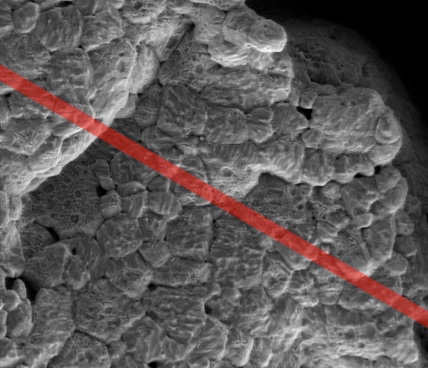
The surface of a ceramic with the (highly ideal) 5 micrometer wide ice-cream-molecule-stripping path of a spoon.
As undeniably clever as the approach above is, that “10,000,000 passes with a spoon” estimate is built on unrealistic premises. Sadly, you can’t eat all the ice cream in a conventional bowl using compulsive spooning alone.
But that doesn’t mean it’s impossible eat all of the ice cream, you just have to stretch the rules a little. For example, you could eat as much as you would like, then put the bowl into a kiln. By and large, organic molecules (sugar, fat, cellulose, etc.) burn at temperatures below 500°F and turn into new compounds, and a good kiln heats things up to 1700°F. A ceramic bowl would survive the heat intact, but the chemicals that make ice cream ice cream (as opposed to ash) wouldn’t.
So if you define “eating all the ice cream in the bowl” as “there was ice cream, I ate ice cream, now it’s all gone”, a kiln is a good way to do it. But if you think destroying the evidence is somehow cheating, there is one more, perhaps not as delicious, alternative guaranteed to work.
Eat the bowl.
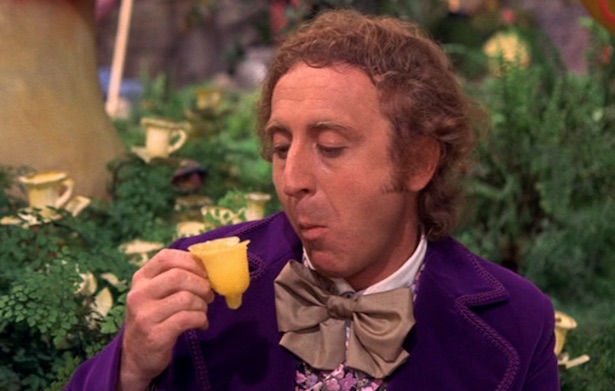
Willy Wonka demonstrating the simplest solution for consuming every atom of ice cream (or whatever else).
The empty ice cream bowl picture is from here.
The extreme close-up of a ceramic is from here.
The kiln picture is from here.
The Willy Wonka picture is from Willy Freaking Wonka.

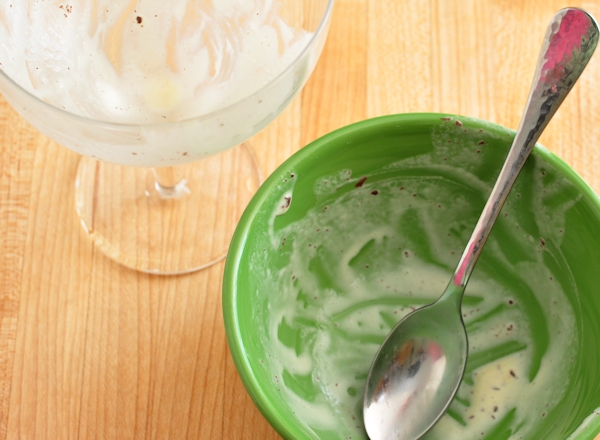
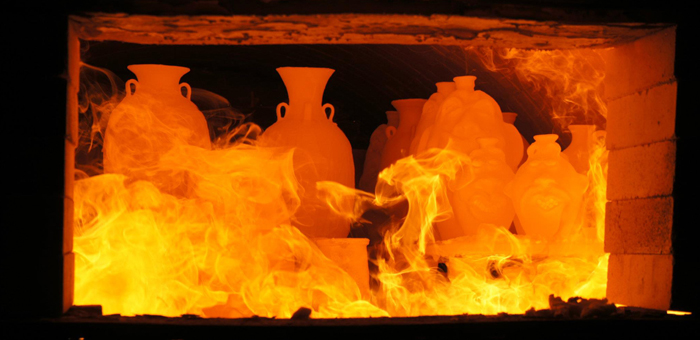






Wonderful
What about licking the bowl? Or would that still leave traces of ice cream no matter how thoroughly you licked it?
@Brigid
A tongue, being adaptable, solves the problem of matching curvature, but both surfaces are still far too complex. There’s lots of unavoidable pockets and cracks for ice cream to hide.
Fill the bowl with water and drink it often enough that statistically all of the original molecules are consumed.
What if you kept filling the bowl with water to dissolve the remaining molecules, then drank the water, and repeated until there were no more molecules left that were originally part of the ice cream?
The formula
\frac{1}{2(0.01m)}x^2-\frac{1}{2(0.07m)}x^2=0.25\times10^{-9}m. Solve for x and you get x=2.4\times10^{-6}m,
is only valid for vanilla ice cream. Chocolate, strawberry and any ice cream with nuts or fruits requires factoring in the atomic weights of the component elements.
This is very interesting and I could finally be proud that I haven’t eaten it all :). Will there be any molecules left even if I am to fill the bowl with water and then drink it?
When you drink from a bowl you never leave it completely dry. While each round of filling the bowl with water and drinking it will literally water down the remaining ice cream, it would take a long time to be sure that you’ve removed every molecule.
How do you define “eat”? Is it mastication. If it is mastication then at a certain point nothing in the bowl can be masticated and you’ve “eaten”All the ice cream. Any remaining ice cream has been liquefied and can’t be eaten
Change “eat” to “consume” or “ingest”
I have irrefutable proof that it is not possible to eat all the ice cream in a bowl.
According to my dog, there are always some remaining molecules of ice cream to be consumed.